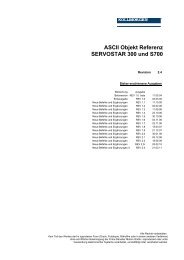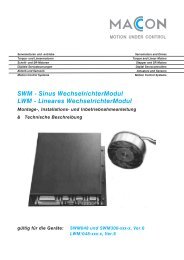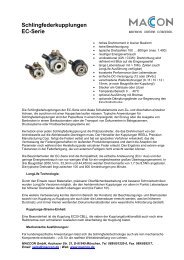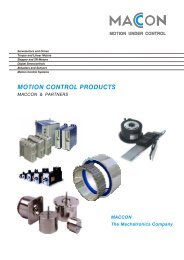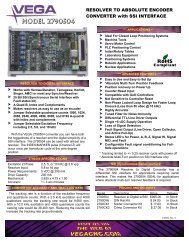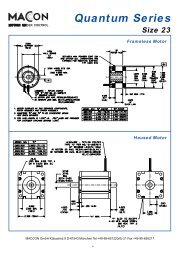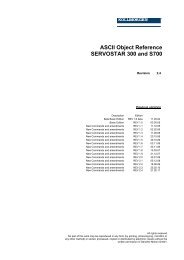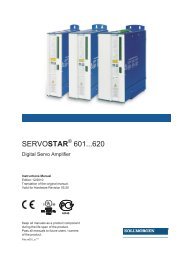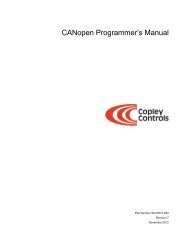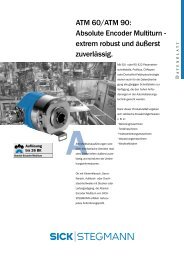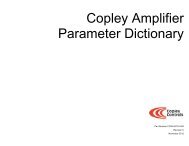Datasheet Stepnet Panel - Maccon.de
Datasheet Stepnet Panel - Maccon.de
Datasheet Stepnet Panel - Maccon.de
Create successful ePaper yourself
Turn your PDF publications into a flip-book with our unique Google optimized e-Paper software.
Control Mo<strong>de</strong>s<br />
• In<strong>de</strong>xer, Point-to-Point, PVT<br />
• Camming, Gearing<br />
• Position, Velocity, Torque [Servo Mo<strong>de</strong>]<br />
• Position (Microstepping)<br />
Command Interface<br />
• CANopen<br />
• ASCII and discrete I/O<br />
• Stepper commands<br />
• PWM velocity/torque command<br />
• Master enco<strong>de</strong>r [Gearing/Camming]<br />
Communications<br />
• CANopen<br />
• RS-232<br />
Feedback<br />
• Digital Quad A/B enco<strong>de</strong>r<br />
I/O - Digital<br />
• 12 inputs, 4 outputs<br />
Dimensions: in [mm]<br />
• 5.35 x 3.29 x 1.65 [135.9 x 83.5 x 41.8]<br />
DESCRIPTION<br />
<strong>Stepnet</strong> <strong>Panel</strong><br />
<strong>Stepnet</strong> is a stepping motor drive that combines CANopen<br />
networking with 100% digital control of stepping motors. When<br />
used with Copleys’ Accelnet and Xenus digital servo drives it<br />
makes possible brushless, brush, and stepping motor control over<br />
the same distributed network.<br />
In Servo Mo<strong>de</strong>, steppers fitted with enco<strong>de</strong>rs can be operated as<br />
DC brushless servo motors in current, velocity or position mo<strong>de</strong>s.<br />
This enables the motor to operate at higher RPM’s without stalling<br />
which might occur in open-loop operation as a stepper.<br />
<strong>Stepnet</strong> can operate as a stand-alone drive accepting incremental<br />
position commands from step-motor controllers in Step/Direction<br />
or CU/CD format, as well as A/B quadrature commands from a<br />
master-enco<strong>de</strong>r. Pulse to motor position ratio is programmable for<br />
electronic gearing.<br />
Set up is fast and simple using CME 2 software operating un<strong>de</strong>r<br />
Windows® and communicating with <strong>Stepnet</strong> via an RS-232 link.<br />
CAN address selection is programmable in flash memory, by rotary<br />
switch on the unit or via programmable digital inputs.<br />
<strong>Stepnet</strong> operates as a Motion Control Device un<strong>de</strong>r the DSP-402<br />
protocol of the CANopen DS-301 V4.01 (EN 50325-4) application<br />
layer. DSP-402 mo<strong>de</strong>s supported inclu<strong>de</strong>: Profile Position, Profile<br />
Velocity, Interpolated Position Mo<strong>de</strong> (PVT), and Homing Mo<strong>de</strong>s.<br />
When operating in Servo Mo<strong>de</strong> , Profile Torque mo<strong>de</strong> is available.<br />
The CAN bus interface is optically isolated from the drive circuits.<br />
Profile Position mo<strong>de</strong> does a complete motion in<strong>de</strong>x on command<br />
with acceleration & <strong>de</strong>celeration, top speed, and distance<br />
programmable.<br />
Mo<strong>de</strong>l Ip Ic Vdc<br />
STP-075-07 7 5 75<br />
STP-075-10 10 10 75<br />
STP<br />
DIGITAL DRIVE<br />
FOR STEPPER MOTORS<br />
Copley Controls, 20 Dan Road, Canton, MA 02021, USA Tel: 781-828-8090 Fax: 781-828-6547<br />
Web: www.copleycontrols.com Page 1 of 16<br />
R<br />
RoHS<br />
In PVT (Position-Velocity-Time) mo<strong>de</strong>, the controller sends out a<br />
sequence of points each of which is an increment of a larger, more<br />
complex move than that of a single in<strong>de</strong>x or profile. The drive<br />
then uses cubic polynomial interpolation to “connect the dots”<br />
such that the motor reaches each point (Position) at the specified<br />
velocity (Velocity) at the prescribed time (Time). Homing mo<strong>de</strong> is<br />
configurable to work with a combination of limit and home switches<br />
such that the drive moves the motor into a position that has an<br />
absolute reference to some part of the machine. Profile Velocity<br />
mo<strong>de</strong> controls velocity, acceleration, and <strong>de</strong>celeration with no target<br />
position <strong>de</strong>fined.<br />
There are twelve logic inputs. Input [IN1] is <strong>de</strong>dicated for drive<br />
Enable. Eleven are programmable as limit or home switches,<br />
stepper pulse inputs, A/B enco<strong>de</strong>r, reset, CAN address, or motor<br />
overtemperature sensor. There are four programmable logic outputs<br />
for reporting a drive fault, operating a motor-mounted brake, or<br />
other status indications. When operating as a no<strong>de</strong> on a CANopen<br />
network, the inputs and outputs can be read or controlled as<br />
in<strong>de</strong>pen<strong>de</strong>nt I/O points that are not linked to drive operation.<br />
An Aux HV input is provi<strong>de</strong>d for “keep alive” power that preserves<br />
the drive data (e.g. current position) and CANopen operation if +HV<br />
has been removed as in an emergency-stop situation. This enables<br />
the control system to monitor drive status and to enable an or<strong>de</strong>rly<br />
recovery without a full system reset, and homing of all axes.<br />
Operation from transformer-isolated DC power supplies saves cost<br />
in multi-axis systems.
<strong>Stepnet</strong> <strong>Panel</strong><br />
GENERAL SPECIFICATIONS<br />
Test conditions: Load = 1mH per phase, ambient temperature = 25 °C. +HV = HV max<br />
MODEL STP-075-07 STP-075-10<br />
OUTPUT POWER<br />
Peak Current 7 (5) 10 (7) Adc (Arms, sinusoidal)<br />
Peak time 1 1 s<br />
Continuous current 5 (3.54) 10 (7) Adc (Arms, sinusoidal)<br />
INPUT POWER<br />
HV min to HV max +20 to +75 +20 to +75 Vdc,transformer-isolated<br />
Ipeak 8 11 Adc (1 sec)<br />
Icont 5.5 11 Adc<br />
Aux HV +20 to +75 +20 to +75 Vdc<br />
CURRENT CONTROL<br />
Current loop update rate 15 kHz (66.7 µs)<br />
PWM outputs Dual MOSFET H-bridges, 15 kHz center-weighted PWM, space-vector modulation<br />
PWM ripple frequency 30 kHz<br />
HV Compensation Changes in HV do not affect current-loop bandwidth<br />
STP<br />
REFERENCE INPUTS<br />
CAN bus Operating Mo<strong>de</strong>s Profile Position, Profile Velocity, Interpolated Position,<br />
and Homing mo<strong>de</strong>s. Profile Torque when in Servo Mo<strong>de</strong><br />
Digital position reference Step/Direction, CountUp/CountDown Stepper command pulses ( 1 MHz maximum rate )<br />
Quad A/B Enco<strong>de</strong>r 5 Mline/sec, 20 Mcount/sec (after quadrature)<br />
Digital torque or velocity reference (Servo mo<strong>de</strong> only) PWM/polarity or 50% PWM format<br />
DIGITAL INPUTS (NOTE 1)<br />
Quantity 12<br />
Enable [IN1] Dedicated input for drive enable, 33 µs RC filter, 10 kΩ pull-up/down to +5/ground<br />
GP [IN2,3,4,5] General Purpose inputs with 33 µs RC filters (22 µs for [IN5]), programmable functions<br />
and active level select, 10 kΩ pull-up/down to +5/ground, Vin = 0 to +30 Vdc<br />
HS [IN6,7,8,9,10,11,12] High-Speed Inputs inputs with 100 ns RC filters, programmable functions, and active level select<br />
10 kΩ pull-up/down to +5/ground, Vin = 0 to +12 Vdc<br />
All inputs 74HC14 Schmitt trigger operating from +5.0 V with RC filter on input, 10 kΩ pull-up/down to +5/ground<br />
RC time-constants assume active drive on inputs and do not inclu<strong>de</strong> 10 kΩ resistors<br />
Logic levels Vin-LO < +1.35 Vdc, Vin-HI > +3.65 Vdc<br />
DIGITAL OUTPUTS<br />
Quantity 4<br />
Type Current-sinking MOSFET open-drain outputs with<br />
1 kΩ pullup to +5 Vdc through dio<strong>de</strong>, 1 Adc sink max, +30 Vdc max.<br />
The sum of all digital output currents cannot exceed 2 Adc<br />
Functions Programmable with CME 2<br />
Active Level Programmable to either HI (off, pull-up to +5 Vdc) or LO (on, current-sinking) when output is active<br />
RS-232 COMMUNICATION PORT<br />
Signals RxD, TxD, Gnd<br />
Full-duplex, serial communication port for drive setup and control, 9,600 to 115,200 Baud<br />
CANOPEN COMMUNICATION PORTS<br />
Number Two, optically-isolated from drive circuits<br />
Signals CANH, CANL, Ground, 1 Mbit/sec maximum<br />
Protocol CANopen Application Layer DS-301 V4.01<br />
DSP-402 Device Profile for Drives and Motion Control<br />
MOTOR CONNECTIONS<br />
Motor A+,A-,B+,B- Outputs to 2-phase stepper motor, bipolar drive connected<br />
Motemp Motor temperature sensor or switch. Any input [IN2~IN12] can be programmed for this function<br />
Enco<strong>de</strong>r Quadrature enco<strong>de</strong>r for stall-<strong>de</strong>tection or servo-mo<strong>de</strong> operation<br />
PROTECTIONS<br />
HV Overvoltage > +91 Vdc Drive outputs turn off until +HV is < overvoltage<br />
HV Un<strong>de</strong>rvoltage < +20 Vdc Drive outputs turn off until +HV >= +20 Vdc<br />
Drive over temperature PC Board > 70 °C. Programmable actions<br />
Short circuits Output to output, output to ground, internal PWM bridge faults<br />
I 2 T Current limiting Programmable: continuous current, peak current, peak time<br />
Latching / Non-Latching Programmable<br />
AGENCY CONFORMANCE<br />
EN 55011 : 1998 CISPR 11 (1997) Edition 2/Amendment 2:<br />
Limits and Methods of Measurement of Radio Disturbance Characteristics of<br />
Industrial, Scientific, and Medical (ISM) Radio Frequency Equipment<br />
EN 61000-6-1 : 2001 Electromagnetic Compatibility Generic Immunity Requirements<br />
Following the provisions of EC Directive 89/336/EEC:<br />
EN 60204-1: 1997 Safety of Machinery. Electrical Equipment of Machines<br />
Following the provisions of EC Directive 98/37/EC:<br />
UL 508C : 1996 UL Standard for Safety for Power Conversion Equipment<br />
NOTES 1. [IN1] is not programmable and always works as drive Enable. Other digital inputs are programmable.<br />
Copley Controls, 20 Dan Road, Canton, MA 02021, USA Tel: 781-828-8090 Fax: 781-828-6547<br />
Web: www.copleycontrols.com Page 2 of 16<br />
RoHS
DIMENSIONS<br />
.19 4.83<br />
.19 4.83<br />
3.24 82.22<br />
0.19 (4.8)<br />
0.16<br />
(4.1)<br />
0.15 (3.8)<br />
<strong>Stepnet</strong> <strong>Panel</strong><br />
5.35 135.89<br />
4.97 126.24<br />
5.00 127<br />
4.97 126.24<br />
Heatsink is optional<br />
5.38 136.53<br />
5.38 (136.5)<br />
5.08 (128.9)<br />
5.00 (127)<br />
Heatsink is optional<br />
.52 13.21<br />
.82 20.83<br />
.6 16.87<br />
0.16<br />
(4.1)<br />
.16 3.96<br />
0.52 (13.2)<br />
2.00<br />
(50.8)<br />
6 places<br />
0.84 [21.3]<br />
0.66 (16.76)<br />
1.49 [37.8]<br />
Copley Controls, 20 Dan Road, Canton, MA 02021, USA Tel: 781-828-8090 Fax: 781-828-6547<br />
Web: www.copleycontrols.com Page 3 of 16<br />
2.00 50.80<br />
.18 4.45<br />
1.65 41.78<br />
3.01 76.38<br />
3.13 (79.4)<br />
STP<br />
RoHS version<br />
(green leaf on label)<br />
Weights: Amplifier 0.94 lb (0.43 kg)<br />
Heatsink 0.4 lb (0.15 kg)<br />
3.51 89.26<br />
3.31 [84.13]<br />
non-RoHS version<br />
(no green leaf on label)<br />
RoHS
FEATURES<br />
<strong>Stepnet</strong><br />
<strong>Stepnet</strong><br />
+<br />
-<br />
<strong>Stepnet</strong> <strong>Panel</strong><br />
Stepper Enco<strong>de</strong>r<br />
+ -<br />
Stall?<br />
Stepper Enco<strong>de</strong>r<br />
STP<br />
<strong>Stepnet</strong> is a DSP based drive for two-phase step motors that operates as a no<strong>de</strong> on a CAN bus or as a stand-alone drive that takes step<br />
motor pulses to command motor position. It operates from line-isolated DC power supplies.<br />
As a CAN no<strong>de</strong> it operates un<strong>de</strong>r the CANopen protocol DSP-402 for motion control <strong>de</strong>vices. The functions supported inclu<strong>de</strong> Profile<br />
Position, Profile Velocity, Interpolated Position, and Homing Mo<strong>de</strong>s. In Profile Position Mo<strong>de</strong> a single PDO (Process Data Object) can<br />
command a position profile with programmable acceleration, <strong>de</strong>celeration, maximum speed, and target position. The acceleration can<br />
be trapezoidal or S-curve. Interpolated Position Mo<strong>de</strong> works with multiple PDO’s each of which specifies position, velocity, and time.<br />
For this reason this mo<strong>de</strong> is sometimes called PVT (Position, Velocity, Time) mo<strong>de</strong>. The drive uses a cubic-interpolation algorithm to<br />
connect the PVT points such that the motor satisfies the PVT parameters at each point while moving along a path that connects the<br />
points smoothly. In PVT mo<strong>de</strong> long moves of complex shapes can be performed. Profile Velocity mo<strong>de</strong> has controlled acceleration,<br />
<strong>de</strong>celeration, and maximum velocity for speed control application with no <strong>de</strong>fined positions. Profile Torque mo<strong>de</strong> is available when the<br />
stepper is operated in Servo Mo<strong>de</strong>.<br />
Multiple axes can be synchronized so that moves are coordinated. This emulates the functions normally performed by motion-controller<br />
cards or chips which can now be eliminated in many cases reducing cost and system complexity.<br />
<strong>Stepnet</strong> also operates as a stand-alone drive taking pulses from controllers that output pulses in the Step/Direction or Count-Up/Count-<br />
Down mo<strong>de</strong>. Electronic gearing is supported when the position commands come from a quadrature enco<strong>de</strong>r. The ratio of enco<strong>de</strong>r counts<br />
at the inputs to microsteps at the motor is programmable.<br />
MICROSTEPPING<br />
Step motors can be viewed as brushless motors with a large number of poles, or electrical<br />
cycles per revolution. The two windings are spaced at 90 electrical <strong>de</strong>grees. Reversing the<br />
currents in each winding produces a 180 <strong>de</strong>gree phase shift. The result is full-stepping. This<br />
kind of operation can be noisy and the large angular change per step excites the rotor to<br />
produce un<strong>de</strong>sirable vibrations. In microstepping, the phase currents are sinusoidal and the<br />
change in electrical angle per step can be programmed such that the motor moves with less<br />
noise and vibration.<br />
Copley Controls, 20 Dan Road, Canton, MA 02021, USA Tel: 781-828-8090 Fax: 781-828-6547<br />
Web: www.copleycontrols.com Page 4 of 16<br />
RoHS<br />
STALL DETECTION<br />
Adding an enco<strong>de</strong>r to the motor gives position feedback to the drive.<br />
When the measured movement of the motor differs from the comman<strong>de</strong>d<br />
position by an amount that is programmable a motor stall is<br />
indicated. The drive can then signal the control system that a motor<br />
stall has occurred, or can send a message over the CAN bus with the<br />
same effect. In this mo<strong>de</strong> the stepper is operated in open-loop mo<strong>de</strong><br />
where the drive changes the phase currents based on the comman<strong>de</strong>d<br />
position of the motor.<br />
SERVO MODE<br />
The stepper motor is now operated as a brushless servo<br />
motor. Motor phase currents are adjusted dynamically<br />
in response to the difference between comman<strong>de</strong>d position<br />
and motor position as fed back by the enco<strong>de</strong>r.<br />
Field-oriented control (vector control) of the motor<br />
currents gives a wi<strong>de</strong>r range of motor speeds without<br />
the possibility of stalling. If the load exceeds motor’s<br />
capability excess following error can be <strong>de</strong>tected and<br />
drive programmed to take appropriate action.
CANOPEN COMMUNICATIONS<br />
<strong>Stepnet</strong> <strong>Panel</strong><br />
CME 2 SOFTWARE<br />
Drive setup is fast and easy using CME 2 software. All of the operations nee<strong>de</strong>d<br />
to configure the drive are accessible through this powerful and intuitive program.<br />
Motor data can be saved as .ccm files. Drive data is saved as .ccx files that contain all drive<br />
settings plus motor data. This eases system management as files can be cross-referenced to<br />
ampifiers. Once a drive configuration has been completed systems can be replicated easily<br />
with the same setup and performance.<br />
RS-232 COMMUNICATION<br />
<strong>Stepnet</strong> is configured via a three-wire, full-duplex RS-232 port that operates from 9,600<br />
to 115,200 Baud. CME 2 software provi<strong>de</strong>s a graphic user interface (GUI) to set up all of<br />
<strong>Stepnet</strong> features via a computer serial port.<br />
Once configured, <strong>Stepnet</strong> can be used in stand-alone mo<strong>de</strong>, or as a networked drive on a<br />
CAN bus.<br />
STP<br />
<strong>Stepnet</strong> drives employ the CAN physical layer which <strong>de</strong>fines the signals, voltage levels, and connections. Once connected as a no<strong>de</strong> on<br />
a CAN (Controller Area Network) they communicate using the CANopen protocol which <strong>de</strong>fines the format of the data flowing over the<br />
bus. The CAN transceiver circuit and local +5 Vdc supply are optically isolated from the drive circuits.<br />
J5 & J6 pins 1,2,3, and 7 are wired to conform to CiA DR-303-1 section 6.4 “RJ45 connector”. Pin 4 <strong>de</strong>signated “reserved” in DR-303-1<br />
is not connected. Pin 8 of J5 & J6 are inter-connected for systems that carry CAN_V+ power. This enables this power to pass through<br />
the drive to other equipment on the CAN. Pin 6, CAN_SHLD connects between J5 & J6 to continue this connection through to other<br />
equipment.<br />
CAN STATUS LED<br />
DRIVE STATE<br />
DRIVE STATUS LED<br />
A single bi-color LED gives the state of the drive by changing color, and either blinking or remaining solid.<br />
The possible color and blink combinations are:<br />
• Green/Solid: Drive OK and enabled. Will run in response to reference inputs or CANopen commands.<br />
• Green/Slow-Blinking: Drive OK but NOT-enabled. Will run when enabled.<br />
• Green/Fast-Blinking: Positive or Negative limit switch active. Drive will only move in direction not inhibited by limit switch.<br />
• Red/Solid: Transient fault condition. Drive will resume operation when fault is removed.<br />
• Red/Blinking: Latching fault. Operation will not resume until amp is Reset<br />
Drive Fault conditions:<br />
• Over or un<strong>de</strong>r-voltage<br />
• Motor over-temperature<br />
• Enco<strong>de</strong>r +5 Vdc fault<br />
• Short-circuits from output to output<br />
• Short-circuits from output to ground<br />
• Internal short circuits<br />
• Drive over-temperature<br />
• Following error<br />
Faults are programmable to be either transient or latching<br />
Copley Controls, 20 Dan Road, Canton, MA 02021, USA Tel: 781-828-8090 Fax: 781-828-6547<br />
Web: www.copleycontrols.com Page 5 of 16<br />
RoHS
<strong>Stepnet</strong> <strong>Panel</strong><br />
STAND-ALONE MODE POSITION-CONTROL INPUTS<br />
<strong>Stepnet</strong> works with motion controllers that output pulses to command position.<br />
The ratio between input pulses and motor revolutions is programmable. These formats are supported:<br />
• Step/Direction:<br />
A pulse-train controls motor position, and the direction is controlled by a DC level at the Direction input.<br />
STP<br />
• CU/CD<br />
CU/CD (Count-Up/Count-Down) pulses turns the motor CW or CCW <strong>de</strong>pending on which input the pulse-train is directed to.<br />
• A/B Quadrature Enco<strong>de</strong>r<br />
The motor can be operated in an electronic gearing mo<strong>de</strong> by connecting the inputs to a master enco<strong>de</strong>r.<br />
STEP/DIRECTION INPUTS COUNT-UP/COUNT-DOWN INPUTS QUAD A/B ENCODER INPUTS<br />
STAND-ALONE MODE TORQUE & VELOCITY INPUTS (SERVO MODE ONLY)<br />
A digital PWM signal controls magnitu<strong>de</strong>, and a DC signal controls polarity.<br />
Copley Controls, 20 Dan Road, Canton, MA 02021, USA Tel: 781-828-8090 Fax: 781-828-6547<br />
Web: www.copleycontrols.com Page 6 of 16<br />
RoHS
DIGITAL INPUTS<br />
<strong>Stepnet</strong> <strong>Panel</strong><br />
STP<br />
<strong>Stepnet</strong> has twelve digital inputs, eleven of which have programmable functions. Input [IN1] is not programmable and is <strong>de</strong>dicated<br />
to the drive Enable function. This is done to prevent acci<strong>de</strong>ntal programming of the input in such a way that the controller could not<br />
shut it down.<br />
Two types of RC filters are used: GP (general purpose) and HS (high speed). Input functions such as Step/Direction, CW/CCW, Quad<br />
A/B are wired to inputs having the HS filters, and inputs with the GP filters are used for general purpose logic functions, limit switches,<br />
and the motor temperature sensor. All inputs have programmable <strong>de</strong>bounce time for reliable operation with electromechanical relays.<br />
Programmable functions of the digital inputs are:<br />
GP inputs HS inputs<br />
• Drive enable (<strong>de</strong>dicated function on [IN1] • Step & Direction, or CU/CD step motor position commands<br />
• Positive Limit switch • Quad A/B master enco<strong>de</strong>r position commands<br />
• Negative Limit switch<br />
• Home switch<br />
• Drive Reset<br />
• Motor over-temperature<br />
• Motion abort<br />
• CAN address bits (IN7~IN10 only)<br />
• PWM Sync input<br />
In addition to the active level and function for each programmable input, the input resistors are programmable in four groups to either<br />
pull up to +5 Vdc, or down to ground. Groun<strong>de</strong>d inputs with HI active levels interface to PLC’s that have PNP outputs that source current<br />
from +24 Vdc sources. Inputs pulled up to +5 Vdc work with open-collector, or NPN outputs that sink current to ground.<br />
GP INPUTS 1,2,3<br />
+30 VDC MAX<br />
GP INPUTS 4,5<br />
+30 VDC MAX<br />
HS INPUTS 6,7,8<br />
+12 VDC MAX<br />
DIGITAL OUTPUTS<br />
Digital outputs are open-drain MOSFETs with 1 kΩ pull-up resistors to +5 Vdc. These can sink<br />
up to 1 Adc from external loads operating from power supplies to +30 Vdc. The sum of all<br />
output currents cannot exceed 2 Adc. When driving inductive loads such as a motor brake,<br />
an external fly-back dio<strong>de</strong> is required. The dio<strong>de</strong> in the output is for driving PLC inputs that<br />
are opto-isolated and connected to +24 Vdc. The dio<strong>de</strong> prevents conduction from +24 Vdc<br />
through the 1 kΩ resistor to +5 Vdc in the drive. This could turn the input on, giving a false<br />
indication of the drive output state.<br />
These outputs are programmable to be on or off when active. Typical functions are drive fault<br />
indication or motor brake operation. Other functions are programmable.<br />
Copley Controls, 20 Dan Road, Canton, MA 02021, USA Tel: 781-828-8090 Fax: 781-828-6547<br />
Web: www.copleycontrols.com Page 7 of 16<br />
RoHS<br />
HS INPUTS 9,10,11,12<br />
+12 VDC MAX
MOTOR PHASE CONNECTIONS<br />
MOTOR ENCODER (OPTIONAL)<br />
<strong>Stepnet</strong> <strong>Panel</strong><br />
The drive output is a dual H-bridge that converts the DC buss voltage (+HV) into sinusoidal<br />
voltage waveforms that drive the motor phases. Cable should be sized for the continuous<br />
current rating of the drive. Motor cabling should use twisted, shiel<strong>de</strong>d conductors for CE<br />
compliance, and to minimize PWM noise coupling into other circuits.<br />
Six <strong>de</strong>dicated inputs accept the enco<strong>de</strong>r A, B, and X (in<strong>de</strong>x) signals. Enco<strong>de</strong>rs with differential<br />
line-drive outputs must be used.<br />
MOTOR BRAKE (OPTIONAL)<br />
Digital outputs [OUT1,2,3,4] can be programmed to power a motor-mounted brake. These<br />
brake the motor when they are in an unpowered state and must have power applied to<br />
release. This provi<strong>de</strong>s a fail-safe function that prevents motor motion if the system is in an<br />
unpowered (uncontrolled) state. Because brakes are inductive loads, an external flyback<br />
dio<strong>de</strong> must be used to control the coil voltage when power is removed. The timing of the<br />
brake is programmable.<br />
MOTOR TEMPERATURE SENSOR (OPTIONAL)<br />
Digital input [IN5] is programmable for use with a motor overtemperature switch. The<br />
input should be programmed as a pull-up to +5 Vdc if the motor switch is groun<strong>de</strong>d.<br />
STP<br />
MOTOR CONNECTIONS<br />
The only motor connections required for stepper operation are the motor phases. These carry the drive output currents that drive the<br />
motor to produce motion. The feedback enco<strong>de</strong>r, brake, and motor over-temperature sensors are optional. If stall-<strong>de</strong>tection is <strong>de</strong>sired<br />
in stepper operation the enco<strong>de</strong>r is required. When operating a stepper as a servo-motor the enco<strong>de</strong>r is also required.<br />
Copley Controls, 20 Dan Road, Canton, MA 02021, USA Tel: 781-828-8090 Fax: 781-828-6547<br />
Web: www.copleycontrols.com Page 8 of 16<br />
RoHS
GROUNDING CONSIDERATIONS<br />
Power and control circuits in <strong>Stepnet</strong> share<br />
a common circuit-ground (Gnd on J1-4,<br />
Signal Ground on J3-7 & 25 and J4-3 & 4).<br />
Input logic circuits are referenced to Signal<br />
Ground, as are power GND, digital outputs,<br />
and enco<strong>de</strong>r. For this reason, drive Gnd<br />
terminals should connect to the users’ common<br />
ground system so that signals between<br />
drive and controller are at the same common<br />
potential, and to minimize noise. The<br />
system ground should, in turn, connect to<br />
an earthing conductor at some point so that<br />
the whole system is referenced to “earth”.<br />
The CAN ports are optically isolated from<br />
the drive circuits.<br />
Because current flow through conductors<br />
produces voltage-drops across them, it is<br />
best to connect the drive HV GND to system<br />
earth, or circuit-common through the shortest<br />
path, and to leave the power-supply<br />
floating. In this way, the power supply (-)<br />
terminal connects to ground at the drive<br />
HV Return terminals, but the voltage drops<br />
across the cables will not appear at the drive<br />
ground, but at the power supply negative<br />
terminal where they will have less effect.<br />
For CE compliance drive cables should be<br />
shiel<strong>de</strong>d. Motor phase currents are balanced,<br />
but currents can flow between the<br />
PWM outputs, and the motor cable shield.<br />
<strong>Stepnet</strong> <strong>Panel</strong><br />
Drive<br />
To minimize the effects of these currents<br />
on nearby circuits, the cable shield should<br />
connect to Frame Gnd (J2-1). Power supply<br />
wiring should also be shiel<strong>de</strong>d and shield<br />
connected to J1-1, and pin 9 of J3 connects<br />
the control cable shield to frame ground. The<br />
drive case (Frame Ground, or F.G.) does not<br />
connect to any drive circuits. Connections to<br />
F.G. are provi<strong>de</strong>d on connectors J1-1, J2-1,<br />
and J3-9. When installed, the drive case<br />
should connect to the system chassis. This<br />
maximizes the shielding effect of the case,<br />
and provi<strong>de</strong>s a path to ground for noise currents<br />
that can occur in the cable shields.<br />
Signals from controller to drive are referenced<br />
to +5 Vdc, and other power supplies<br />
in user equipment. These power supplies<br />
should also connect to system ground and<br />
earth at some point so that they are at<br />
same potential as the drive circuits. The<br />
final configuration should embody three<br />
current-carrying loops. First, the power<br />
supply currents flowing into and out of the<br />
drive at the +HV and Gnd pins on J1. Second<br />
the drive outputs driving currents into and<br />
out of the motor phases, and motor shield<br />
currents circulating between the A+, A-,<br />
B+, & B- outputs and Gnd. And, lastly, logic<br />
and signal currents connected to the drive<br />
control inputs and outputs.<br />
POWER SUPPLIES<br />
STP<br />
Copley Controls, 20 Dan Road, Canton, MA 02021, USA Tel: 781-828-8090 Fax: 781-828-6547<br />
Web: www.copleycontrols.com Page 9 of 16<br />
RoHS<br />
<strong>Stepnet</strong> operates typically from transformer-isolated,<br />
unregulated DC power supplies.<br />
These should be sized such that the<br />
maximum output voltage un<strong>de</strong>r high-line<br />
and no-load conditions does not exceed the<br />
drives maximum voltage rating. Power supply<br />
rating <strong>de</strong>pends on the power <strong>de</strong>livered to<br />
the load by the drive. Unlike servo motors<br />
that consume little power at a standstill,<br />
steppers dissipate power continuously when<br />
in-position. This can vary from full rated<br />
current in both windings to something less<br />
based on programmed value of holding<br />
current.<br />
Power supplies should be chosen with continuous<br />
power ratings that are sufficient for<br />
the motor in use.<br />
Operation from regulated switching power<br />
supplies is possible if a dio<strong>de</strong> is placed between<br />
the power supply and drive to prevent<br />
regenerative energy from reaching the<br />
output of the supply. If this is done, there<br />
must be external capacitance between the<br />
dio<strong>de</strong> and drive.<br />
AUXILIARY HV POWER<br />
<strong>Stepnet</strong> has an input for AUX HV. This is a<br />
voltage that can keep the drive communications<br />
and feedback circuits active when<br />
the PWM output stage has been disabled<br />
by removing the main +HV supply. This<br />
can occur during EMO (Emergency Off)<br />
conditions where the +HV supply must be<br />
removed from the drive and powered-down<br />
to ensure operator safety. The AUX HV input<br />
operates from any DC voltage that is within<br />
the operating voltage range of the drive and<br />
powers the DC/DC converter that supplies<br />
operating voltages to the drive DSP and<br />
control circuits.<br />
When the drive +HV voltage is greater than<br />
the AUX-HV voltage it will power the DC/DC<br />
converter. Un<strong>de</strong>r these conditions the AUX-<br />
HV input will draw no current.
DRIVE CONNECTIONS<br />
<strong>Stepnet</strong> <strong>Panel</strong><br />
STP<br />
Notes<br />
1. The functions of input signals [IN2~IN12] are programmable. Default functions are shown.<br />
2. The function of [IN1] on J3-3 is always Drive Enable and is not programmable.<br />
The active level of [IN1] is programmable, and resetting the drive with changes on the enable input is programmable.<br />
3. The functions of [OUT1~OUT4] are programmable. The functions shown are typical.<br />
The sum of all output currents cannot exceed 2 Adc.<br />
Copley Controls, 20 Dan Road, Canton, MA 02021, USA Tel: 781-828-8090 Fax: 781-828-6547<br />
Web: www.copleycontrols.com Page 10 of 16<br />
RoHS
CONNECTORS & SIGNALS<br />
J3 CABLE CONNECTOR:<br />
26-Position, High-<strong>de</strong>nsity D-Sub, male<br />
CAN signals<br />
within<br />
dashed line<br />
are isolated<br />
from amplifier<br />
See J4-J5 Notes<br />
J4SIGNALS Pin<br />
Noconnect 1<br />
RxD Input<br />
2<br />
Signal Ground 3<br />
Signal Ground 4<br />
TxD Output<br />
5<br />
Noconnect 6<br />
J3 SIGNALS PIN PIN J3 SIGNALS<br />
J3 SIGNALS PIN Output 4 [OUT4] 18 9 Frame ground<br />
Output 3 [OUT3] 26 Output 2 [OUT2] 17 8 [OUT1] Output 1<br />
Signal ground 25 Enco<strong>de</strong>r +5 Vdc 16 7 Signal ground<br />
Enco<strong>de</strong>r input /X 24 Enco<strong>de</strong>r input /B 15 6 Enco<strong>de</strong>r input /A<br />
Enco<strong>de</strong>r input X 23 Enco<strong>de</strong>r input B 14 5 Enco<strong>de</strong>r input A<br />
Programmable input [IN12] 22 Programmable input [IN8] 13 4 [IN4] Programmable Input<br />
Programmable input [IN11] 21 Programmable input [IN7] 12 3 [IN3] Programmable Input<br />
Programmable input [IN10] 20 Programmable input [IN6] 11 2 [IN2] Programmable Input<br />
Programmable input [IN9] 19 Programmable input [IN5] 10 1 [IN1] Enable<br />
J5, J6<br />
SIGNALS Pin<br />
1 ( CAN_V+<br />
) 8<br />
CAN_GND 7<br />
1 ( CAN_SHLD)<br />
6<br />
1 Reserved 5<br />
Noconnection 4<br />
CAN_GND 3<br />
<strong>Stepnet</strong> <strong>Panel</strong><br />
Sol<strong>de</strong>r-Cup:<br />
Connector: Norcomp, Inc. PN: 180-026-103L001 (or equivalent)<br />
Backshell: Century Interconnect PN: CHS15B (or equivalent)<br />
Poke & crimp:<br />
Connector: Norcomp, Inc. PN: 180-026-173L000 (or equivalent)<br />
Contacts: Norcomp, Inc. PN: 180-001-170L001 (or equivalent, for AWG 24~26)<br />
Crimping tool: Norcomp, Inc PN: 180-701-170-000<br />
Backshell: Century Interconnect PN: CHS15B (or equivalent)<br />
Cable: 26 conductor, shiel<strong>de</strong>d<br />
J4 CABLE CONNECTOR:<br />
RJ-11 style, male, 6 position<br />
Cable: 6-conductor modular type<br />
CAN_L 2<br />
CAN_H 1<br />
J4, J5 CABLE CONNECTOR:<br />
RJ-45 style, male, 8 position<br />
Cable: 8-conductor modular type<br />
J3<br />
J4<br />
J5<br />
J6<br />
S1<br />
F.G.<br />
Frame ground via<br />
tapped hole in heatplate<br />
PINJ2SIGNALS 1 Fram<br />
e Groun<br />
d<br />
2 Moto<br />
r B-<br />
3 Moto<br />
r B+<br />
4 Moto<br />
r A-<br />
5 Moto<br />
r A+<br />
J2 CABLE CONNECTOR:<br />
Molex: 39-01-4051 backshell<br />
Molex: 39-00-0039 contact (5)<br />
Cable: AWG 18<br />
PINJ1SIGNALS 1 Frame<br />
Ground<br />
2 Aux<br />
HV<br />
3 + HV<br />
Input<br />
4 GND<br />
J1 CABLE CONNECTOR:<br />
Molex: 39-01-4041 backshell<br />
Molex: 39-00-0039 contact (4)<br />
Cable: AWG 18<br />
J4-J5 Notes<br />
1. These signals interconnect between J4 & J5 but have no internal connections to the drive<br />
2. CAN circuits are optically-isolated from drive circuits<br />
STP<br />
Copley Controls, 20 Dan Road, Canton, MA 02021, USA Tel: 781-828-8090 Fax: 781-828-6547<br />
Web: www.copleycontrols.com Page 11 of 16<br />
J2<br />
J1<br />
RoHS
CANOPEN CONFIGURATION<br />
+HV<br />
+HV<br />
<strong>Stepnet</strong> <strong>Panel</strong><br />
+HV, MOTOR,<br />
& CONTROL<br />
CONNECTOR KIT<br />
STP-CK<br />
POWER SUPPLY<br />
Mains-isolated DC<br />
Required for all systems<br />
User-supplied<br />
SERIAL CABLE KIT (1)<br />
SER-CK<br />
CAN NETWORK CABLE (3)<br />
STP-NC-10 (10 ft)<br />
STP-NC-01 (1 ft)<br />
CAN TERMINATOR (2)<br />
(for last no<strong>de</strong> on CAN bus)<br />
PART<br />
NUMBER<br />
DESCRIPTION<br />
STP-075-07 <strong>Stepnet</strong> CANopen Stepper Drive 5/7 Adc @ 75 Vdc<br />
STP-075-10 <strong>Stepnet</strong> CANopen Stepper Drive 10/10 Adc @ 75 Vdc<br />
STP-CK<br />
Connector Kit for <strong>Stepnet</strong> (J1 & J2 connector shells & crimp<br />
contacts ,and plug with sol<strong>de</strong>rcups & backshells for J3)<br />
STP-NK CANopen Network Kit<br />
STP-HK Heatsink Kit (for field installation)<br />
STP-CV DB-9 Female to RJ45 Adapter Assembly<br />
STP-NC-10 CAN network cable, 10 ft (3 m)<br />
STP-NC-01 CAN network cable, 1 ft (0.3 m)<br />
STP-NT CAN Network Terminator<br />
CME 2 CME 2 CD (CME 2, Manual)<br />
SER-CK Serial Cable Kit<br />
Multiple drives are connected as<br />
no<strong>de</strong>s on a CAN bus<br />
STP<br />
Individual drives are configured<br />
using an RS-232 connection and<br />
CME 2 software<br />
CANOPEN NETWORK KIT (2)<br />
STP-NK<br />
AUX HV POWER SUPPLY<br />
AUX HV STP-HK<br />
(Optional)<br />
Copley Controls, 20 Dan Road, Canton, MA 02021, USA Tel: 781-828-8090 Fax: 781-828-6547<br />
Web: www.copleycontrols.com Page 12 of 16<br />
RoHS<br />
Notes:<br />
1. Only one SER-CK is nee<strong>de</strong>d per installation<br />
2. CANopen Network Kit STP-NK inclu<strong>de</strong>s D-Sub 9 to RJ-45<br />
adapter, 10 ft. modular cable, and CAN bus terminator<br />
3. Or<strong>de</strong>r one cable (1 or 10 ft) for each additional drive<br />
HEATSINK<br />
(Optional)
STAND-ALONE CONFIGURATION<br />
+HV<br />
AUX HV<br />
<strong>Stepnet</strong> <strong>Panel</strong><br />
+HV, MOTOR,<br />
& CONTROL<br />
CONNECTOR KIT<br />
STP-CK<br />
POWER SUPPLY<br />
SER-CK<br />
Mains-isolated DC<br />
Required for all systems<br />
User-supplied<br />
AUX HV POWER SUPPLY<br />
(Optional)<br />
SERIAL CABLE KIT (1)<br />
Notes:<br />
1. Only one SER-CK is nee<strong>de</strong>d per installation<br />
PART<br />
NUMBER<br />
DESCRIPTION<br />
STP-075-07 <strong>Stepnet</strong> CANopen Stepper Drive 5/7 Adc @ 75 Vdc<br />
STP-075-10 <strong>Stepnet</strong> CANopen Stepper Drive 10/10 Adc @ 75 Vdc<br />
STP-CK<br />
Connector Kit for <strong>Stepnet</strong> (J1 & J2 connector shells & crimp<br />
contacts ,and plug with sol<strong>de</strong>rcups & backshells for J3)<br />
CME 2 CME 2 CD (CME 2, Manual)<br />
SER-CK Serial Cable Kit<br />
Stepper Motor Control Signals:<br />
Step/Direction<br />
CU/CD<br />
Electronic Gearing Signals:<br />
A/B Quadrature enco<strong>de</strong>r<br />
CME 2 is used for setup and<br />
configuration.<br />
STP-HK Heatsink Kit (for field installation)<br />
STP-HK<br />
HEATSINK<br />
(Optional)<br />
STP<br />
Copley Controls, 20 Dan Road, Canton, MA 02021, USA Tel: 781-828-8090 Fax: 781-828-6547<br />
Web: www.copleycontrols.com Page 13 of 16<br />
RoHS
POWER DISSIPATION<br />
ROHS VERSION<br />
NON-ROHS VERSION<br />
Power Dissipation (W)<br />
Power Dissipation (W)<br />
25<br />
20<br />
15<br />
10<br />
5<br />
0<br />
20<br />
15<br />
10<br />
5<br />
0<br />
0<br />
0<br />
<strong>Stepnet</strong> <strong>Panel</strong><br />
Drive dissipation vs.<br />
Output Current<br />
1<br />
Drive dissipation vs.<br />
Output Current<br />
1<br />
2<br />
2<br />
3<br />
3<br />
4<br />
4<br />
5<br />
5<br />
6<br />
6<br />
Output current (A)<br />
Output current (A)<br />
7<br />
7<br />
8<br />
8<br />
9<br />
9<br />
+HV (Vdc)<br />
75 V<br />
10<br />
+HV (Vdc)<br />
75 V<br />
55 V<br />
25 V<br />
Copley Controls, 20 Dan Road, Canton, MA 02021, USA Tel: 781-828-8090 Fax: 781-828-6547<br />
Web: www.copleycontrols.com Page 14 of 16<br />
7.3 W<br />
10<br />
55 V<br />
25 V<br />
9.9 W<br />
STP<br />
The chart on this page shows the internal power dissipation for <strong>Stepnet</strong> un<strong>de</strong>r differing power supply and output current<br />
conditions. The output current is calculated from the motion profile, motor, and load conditions. The values on the chart<br />
represent the rms (root-mean-square) current that the drive would provi<strong>de</strong> during operation. The +HV values are for<br />
the average DC voltage of the power supply.<br />
When +HV and drive output current are known, the amplifier power dissipation can be found from the charts. The next<br />
step is to <strong>de</strong>termine the temperature rise the drive will experience when it’s installed. For example, if the ambient temperature<br />
in the enclosure is 40 °C, and the heatplate temperature is to be limited to 65 °C to avoid shutdown, the rise<br />
would be 25 °C above ambient.<br />
Divi<strong>de</strong> the temperature rise by the power dissipation to yield a result in units of °C/W. For a <strong>Stepnet</strong> operating at 75 Vdc<br />
and outputting 5 A, the dissipation would be about 9.9 W. This would give 25 °C/9.9W, or 2.5 °C/W as the maximum<br />
thermal resistance (R ) of a heatsink.<br />
th<br />
From the tables on the opposite page it can be seen that RoHS <strong>Stepnet</strong> will work in this application without heatsink if<br />
there is some forced-air cooling.<br />
RoHS
STEPS TO INSTALL<br />
1. Place the PSM on the <strong>Stepnet</strong> aluminum<br />
heatplate taking care to center the PSM<br />
holes over the holes in the drive body.<br />
2. Mount the heatsink onto the PSM again<br />
taking care to see that the holes in the<br />
heatsink, PSM, and drive all line up.<br />
3. Torque the #6-32 mounting screws to<br />
8~10 lb-in (0.9~1.13 N·m).<br />
<strong>Stepnet</strong> <strong>Panel</strong><br />
NO HEATSINK °C/W<br />
CONVECTION 2.8<br />
FORCE AIR (100 LFM) 1.3<br />
STP-HS HEATSINK °C/W<br />
CONVECTION <br />
FORCE AIR (100 LFM) 0.8<br />
FORCE AIR (200 LFM) 0.6<br />
STP<br />
MOUNTING & COOLING<br />
<strong>Stepnet</strong> has slots for mounting to panels at 0° or 90°. Cooling is by conduction from drive heatplate to mounting surface, or by convection<br />
to ambient.<br />
A heatsink (optional) is required for the drive to <strong>de</strong>liver the rated continuous output current. Depending on the drive mounting and<br />
cooling means this may not be required.<br />
HEATSINK OPTIONS<br />
NO HEATSINK<br />
WITH HEATSINK (STP-HS)<br />
HEATSINK INSTALLATION<br />
R th expresses the rise in temperature of the amplifier per Watt of internal power loss. The<br />
units of R th are °C/W, where the °C represent the rise above ambient in <strong>de</strong>grees Celsius.<br />
The data below show thermal resistances un<strong>de</strong>r convection, or fan-cooled conditions for<br />
the no-heatsink and heatsink.<br />
The heatsink is mounted using the same type of screws used to mount the drive to a panel. Phase change material (PSM)<br />
is used in place of thermal grease. This material comes in sheet form and changes from solid to liquid form as the drive<br />
warms up. This forms an excellent thermal path from drive heatplate to heatsink for optimum heat transfer.<br />
Copley Controls, 20 Dan Road, Canton, MA 02021, USA Tel: 781-828-8090 Fax: 781-828-6547<br />
Web: www.copleycontrols.com Page 15 of 16<br />
PSM<br />
RoHS
MASTER ORDERING GUIDE<br />
ORDERING INSTRUCTIONS<br />
<strong>Stepnet</strong> <strong>Panel</strong><br />
Example: Or<strong>de</strong>r one STP-075-07 drive with heatsink mounted at factory,<br />
and associated components for operation as a CANopen drive:<br />
Qty Item Remarks<br />
1 STP-075-07-H <strong>Stepnet</strong> stepper drive with heatsink mounted<br />
1 STP-CK Connector Kit<br />
1 STP-NK CANopen network kit<br />
1 SER-CK Serial Cable Kit<br />
1 CME2 CME 2 CD<br />
ROHS COMPLIANCE<br />
Mo<strong>de</strong>ls with the green leaf symbol on the<br />
label are RoHS compliant.<br />
Note: Specifications subject to change without notice<br />
STP<br />
Part Number Description<br />
STP-075-07 <strong>Stepnet</strong> CANopen Stepper Drive 5/7 Adc @ 75 Vdc<br />
STP-075-10 <strong>Stepnet</strong> CANopen Stepper Drive 10/10 Adc @ 75 Vdc<br />
STP-CK<br />
Connector kit: J1 & J2 connector shells and crimp contacts, and J3 plug with<br />
sol<strong>de</strong>rcups<br />
STP-NK<br />
CANopen Network Kit: D-Sub 9F to RJ-45 adapter,<br />
10 ft (3 m) CANopen RJ-45 (Ethernet) cable and CAN network terminator<br />
STP-NC-10 CANopen RS-45 (Ethernet) cable, 10 ft (3 m)<br />
STP-NC-01 CANopen RS-45 (Ethernet) cable, 1 ft (0.3 m)<br />
STP-CV CANopen D-Sub 9F to RJ-45 adapter<br />
STP-NT CANopen Network Terminator<br />
SER-CK Serial Cable Kit (1 per computer) for CME2<br />
CME2 CME2 CD-ROM<br />
STP-HK Heatsink kit for field installation<br />
Copley Controls, 20 Dan Road, Canton, MA 02021, USA Tel: 781-828-8090 Fax: 781-828-6547<br />
Web: www.copleycontrols.com Page 16 of 16<br />
RoHS<br />
<strong>Stepnet</strong> <strong>Panel</strong> V9.02_we 05/23/2012




